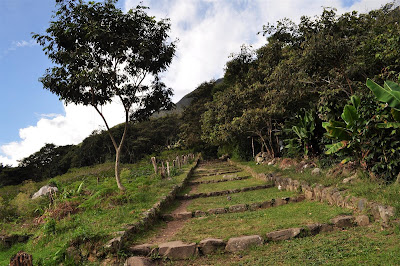




 I just finished a four day trek, the Santa Cruz Trek, through the Cordillera Blanca of Peru. The area known as the Cordillera Blanca is part of the Andes Mountains located in the northern part of Peru. On the first day the guide, Juan, picked me up to start the trek at 6:00 a.m. The road up to the Santa Cruz trek took a long time, we stopped for breakfast in a small town and then continued on. On the way we passed two beautiful lakes, the first lake was called Chinancocha (Laguna Hembra - woman lake) and the second Orconcocha (Laguna Macho - man lake). The original names are in Quechua, which is the native language of a lot of Peruvians. After that we passed through La Quebrada Llanganoco, which had beautiful waterfalls coming down the side of it. At around 1:00 p.m. we started the Santa Cruz Trek from Vaqueria. The first day we walked 13 km uphill. It was a lot of up and down though, we went through many Quechua villages and overall it was pretty, but probably one of the less beautiful days. We learned about how the glaciers are receding and each year they move higher and higher up on the mountain.
I just finished a four day trek, the Santa Cruz Trek, through the Cordillera Blanca of Peru. The area known as the Cordillera Blanca is part of the Andes Mountains located in the northern part of Peru. On the first day the guide, Juan, picked me up to start the trek at 6:00 a.m. The road up to the Santa Cruz trek took a long time, we stopped for breakfast in a small town and then continued on. On the way we passed two beautiful lakes, the first lake was called Chinancocha (Laguna Hembra - woman lake) and the second Orconcocha (Laguna Macho - man lake). The original names are in Quechua, which is the native language of a lot of Peruvians. After that we passed through La Quebrada Llanganoco, which had beautiful waterfalls coming down the side of it. At around 1:00 p.m. we started the Santa Cruz Trek from Vaqueria. The first day we walked 13 km uphill. It was a lot of up and down though, we went through many Quechua villages and overall it was pretty, but probably one of the less beautiful days. We learned about how the glaciers are receding and each year they move higher and higher up on the mountain. On the second day, we woke up at 6:00 a.m. packed up and started our trek over Punta Union. This day we climbed 1000 m only to come back down again. It was a 20 km trek. At the top of Punta Union it was very beautiful, but the walk up it was incredibly difficult. The side of Punta Union that we trekked up was full of clouds so we didn't get a good view, but the opposing side looked down onto a lake, Laguna Taullicocha, and a glacier that fed it, and then down into the valley where there were two other lakes that we would be trekking past in the next few days. We had lunch at Punta Union, which was quite cold. While having lunch we saw a small avalanche come down from the glacier and into the lake, after waiting a bit we continued down to our campsite, Taullipampa. Once we got into the valley we laid in the sun for awhile and then we went on to our campsite.
On the third day we woke up at 5:00 a.m. and walked 26 km (it was longer than the usual third day trip because we did a side trip to Laguna Arhueycocha). We started out the day walking down the valley and then went to the north to climb up a ridge that took us to a lake (Lguna Arhueycocha) at the bottom of a glacier. The view from here was beautiful, we could look down and see a waterfall coming from the lake and the following stream going down into the valley. From here there was also a great view of the Paramount Mountain, which is used as the symbol of the Paramount movie company. The lake was partially man made because it had been lower to help decrease the number of avalanches that came from the glacier above it and destroyed the villages down the valley. After visiting the lake we went back pretty much the way that we came and had lunch next to where the stream from the lake met the steam in the valley. The walk across the valley was pretty easy and flat, and it took us to the first lake, Laguna Jatunocha, and then the second lake, Laguna Ichiccocha. These lakes were absolutely beautiful.
The walk on the fourth day was only about 8 km and it was pretty much just a short trek out of the valley to the village at the end, Cashapampa. However, the trail was along the edge of the valley/canyon (at this point) and it was really hard on the ankles. The sides of the valley were made up of huge boulders and debris and we pretty much just weaved out way amongst them and through them. When we finally reached Cashapampa I was absolutely exhausted and more than ready for a shower and a nap in a real bed.
Overall the Santa Cruz trek was absolutely amazing, the scenery was beautiful and the Quechua villages that we passed through offered a truly unique view into daily life in rural Peru.

No comments:
Post a Comment